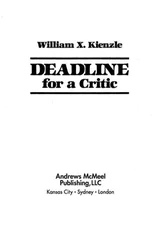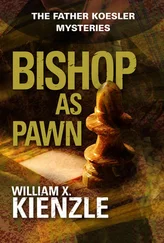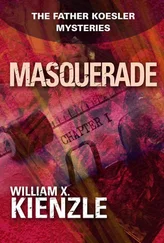“Of course.”
Harris reentered the office. “She’s okay. Just sleeping.”
“She’s been heavily medicated,” Dolly added.
“Did you know Sister Rosamunda was in here?” Koznicki asked.
“No, I didn’t. I knew Sister Eileen was here, of course. But I didn’t know Sister Rosamunda was. She must have come in before I came on duty.”
“Dolly . . .” Father Koesler looked up from his kneeling position; although she was quite obviously dead, he had given the nun conditional absolution. “. . . has John Haroldson been in here since you came on duty?”
“Why, yes . . . just a short while ago. But . . . you don’t think that he—oh, my God! You can’t think that he—”
“Show us to his office, Father. Quickly.” Koznicki was off his knees and pushing Father Koesler out the door.
* * *
All told, there were only six officers and one priest. But because they were all large men, the number seemed larger.
Almost as one they stormed through John Haroldson’s outer office. His secretary was not there. With no preliminaries they burst into his inner office.
Haroldson looked up from his desk. He had been writing. His expression was grave; his visage seemed drained as if he were about to faint.
“Mr. Haroldson . . .” Koznicki began.
Haroldson held up a restraining hand. Everyone stopped in his tracks. For several moments Haroldson continued to write. Then he laid his pen to one side.
He picked up several sheets of paper and offered them to the Inspector. “I believe this is what you want.”
Koznicki did not move to accept the papers. “Before I accept or read what you have written, I will ask Lieutenant Harris to apprise you of your rights.” He nodded to Harris.
Lieutenant Harris took a card from his wallet and began reading the Miranda Warning. Harris of course knew the warning by rote. But reading it was accepted police procedure. Thus, if a defense attorney were to ask an arresting officer how he could be certain he had given the required warning, the officer could honestly respond, “I read it to him.”
The scene resembled a tableau. No one moved as Harris delivered the text. Haroldson continued to extend his papers toward Koznicki, who made no move to accept them. Until the warning was completed.
Then Koznicki asked, “Do you understand what has been read to you, Mr. Haroldson?”
Haroldson nodded and shook the papers insistently.
Koznicki took them, put on his reading glasses and began to peruse the neat, precise script.
Sister! Can you hear me? Can you hear me even though you are dead?
“Mr. Haroldson, Koznicki looked up from the paper, “is this part of something like your diary?”
“Continue reading,” Haroldson replied. “All that you want will be there.”
I am the one who killed you. But you must know that. By now, you must know all the answers.
It was a mistake. It was a mistake ever to have set myself on this course. But that is of little consolation to you. It is too late for consolation. And I must confess I am sorry. But what good does that do you? It is too late for sorrow.
You are dead and this unbearable pain in my head goes on.
It was all so useless.
With all my heart I wish I could change the course of these events. I wish I could change what has already happened. But of course no one can do that. No one can bring you back to life.
If I were to tell this story to someone—and I may very well be forced to do so—where would I start?
I suppose I would start where so many hospital stones begin. In the emergency room . . .
Haroldson’s account went on to tell of how he had been in the background of the emergency room mostly to monitor the new substitute chaplain’s work. While there, Haroldson had noticed this odd character, a volunteer also trying to keep in the background.
Later, in his regular perambulations through the hospital, Haroldson became more aware of this uncoordinated dolt who managed to botch nearly everything he attempted.
Haroldson was about to dismiss the man he had identified as Bruce Whitaker. Even as a volunteer he was costing the hospital far more than he was worth.
And then came the incident of the mutilated curtain hooks. There was no reason for it. The most intriguing feature of the fiasco was that the hooks had been stored in the IUD drawer. He also noted that at a nearby cafeteria table, Whitaker seemed in a state of panicky confusion when the housekeeper presented the curtain hooks.
It had been simple for Haroldson to check out Whitaker. His name was on file as a volunteer. With Haroldson’s civic contacts, he easily learned of Whitaker’s background, his trial and conviction, and present parole. Haroldson recalled well the crime spree waged by Whitaker and his three arch-conservative friends. Armed with that background information, it was not all that difficult to surmise what Whitaker might be up to now.
Haroldson, at that point, made Whitaker a prime subject for surveillance. Gradually, Haroldson ascertained Whitaker’s scheme: to create a media event that would bring to light St. Vincent’s casual approach to authentic Catholic medical-moral ethics.
Well then, the hospital’s ethical standards were those of Sister Eileen. Whitaker’s objective was to force Church authorities to crack down on the hospital’s moral aberrations. If that were to happen, Eileen surely would go. She would not compromise her own beliefs. She was not that sort of person. If Whitaker was successful then not only his goal, but Haroldson’s too, would be achieved. Eileen would be forced out before she could pressure Haroldson into retirement.
What’s more, Whitaker was not trying to seriously harm anyone. Thus Haroldson would be able to oversee Whitaker’s foredoomed endeavors and amend them. All the while, by the principle of the indirect voluntary, Haroldson would be guilty of no sin. At least as far as his own conscience was concerned.
After a while, the revelation went on, it got to be a sort of contest for Haroldson. Surmising what Whitaker’s next ploy would be. Remaining undetected while following him. Trying to figure out what Whitaker was attempting to do when he did it. And finally, correcting Whitaker’s pitiful blunders.
Haroldson chronicled the alteration of Millie Power’s chart and how he removed the sticker that denoted her allergy to penicillin. A sticker that Whitaker unaccountably did not remove. Haroldson surmised that Whitaker’s plans included blowing the whistle before the patient lapsed into a terminal condition. If, typically, Whitaker had fumbled that too, he, Haroldson, would have seen to it.
And it would have worked had not the priest accidentally come upon the scene.
Finally, the statement told of the episode in the OR. His disgust at Whitaker’s feeble attempt to cause a breakdown in OR procedure. Of course it was a good idea; any hospital would be in the news should its OR shut down. But nitrous oxide tanks! The man was a functional idiot.
So, with the sabotaged nitrogen tank Haroldson at last had his media event. An event which Whitaker managed to move from the front page to the comic page. And, as the affair, along with the alleged perpetrator, became a farce, Haroldson’s last hope evaporated.
I cannot express how deep was my depression, how complete my sense of frustration. I had banked everything on being able to manipulate Whitaker to achieve my goal. When that failed, I failed.
That is why, in a moment of utter despondency, I poisoned the medication. I knew that Eileen would need it in the earliest stages of her convalescence. If I could not effect her removal from my beloved hospital, I wanted her dead.
Читать дальше












